Steampunk Hi-Fi: an alternative past sound equipment
Steampunk as an aesthetic concept in the design of Hi-Fi and other audio equipment can not be called a widespread phenomenon. Despite a fairly lively interest in such technology, it rarely falls into the catalogs of online stores and on the shelves of audio equipment stores. I do not know the companies that produce such equipment in series.
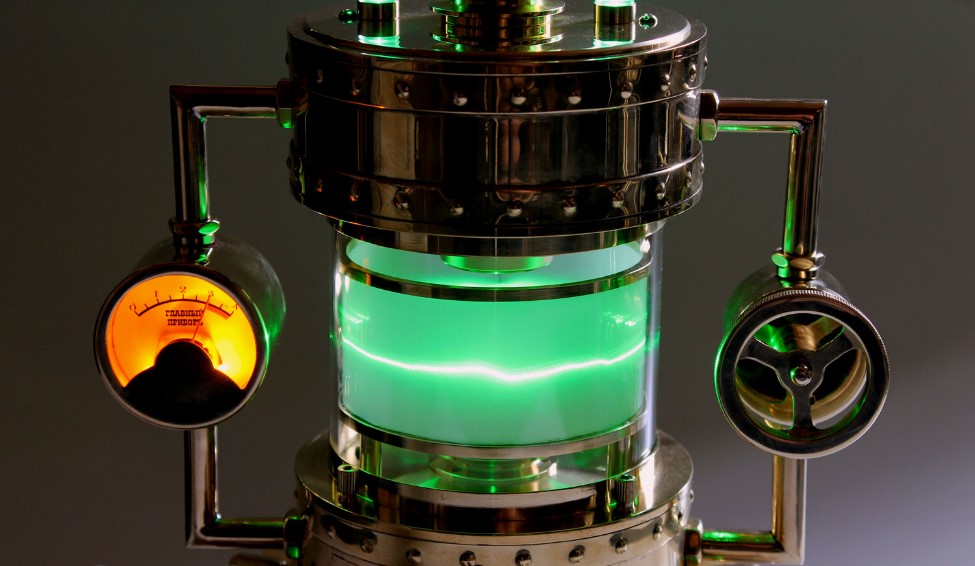
The creators of pseudo-steam and deliberately analog audio works, as a rule, are singles who do for themselves or work on order for a particular client. Often impressive concepts appear not only among professionals, but also among amateurs.
Despite the relatively young fashion in the steampunk design of audio, enthusiasts managed to collect and (or) upgrade (customize) a lot of impressive, unusual devices. It is also interesting that in Russia there appear devices with a characteristic national flavor, some of them deserve special mention. Under the cat will be discussed several experiments in the design of audio devices that impressed me especially.
One of the pioneers of steampunk audio became Copper Steam. The appearance of this laboratory is directly related to the activities and aesthetic preferences of the designer and engineer Michael Cochran. The designer himself considers everything related to his concepts of “insane journey”, which began in 2008 on the wave of the growing popularity of steampunk as a literary and animated genre.
It all started in relatively poor artisanal conditions. The lab was a pair of tables in an old barn in the backyard of a designer house in Orlando. Mike began with the creation of accessories for the interior. The first works were sculptural compositions and pieces of furniture, made in the style characteristic of the steampunk universes.
Four years later, after moving from Orlando to Key West, Mike begins to create the first amplifiers. It should be noted that the designer chose the ideal time for the creation of steampunk amplifiers, since the vintage aesthetics he proposed became a genuine mainstream.
The latter circumstance largely determined the commercial success of the enterprise and made it possible to develop several areas and continue to create devices with a unique appearance. Probably, “warm” tube marketing also played its role. Almost all of the Copper Steam amplification for archaic and brutal trumpiness is based on the vacuum electric devices desired by audiophiles.
Experiments Copper Steam determined the canonical appearance of such devices (amplifiers and speakers). Many of those who began to engage in steampunk design and modding amplifiers relied on the techniques and principles laid down by Michael Cochran.
The first acoustic development of the Copper Steam was a small and low-cost Steam Amp. The model was a set of a complete tube amplifier and speaker system.

The following devices were designed for a more demanding audience, had more power, high fidelity to play and could impress experienced music lovers and audiophiles. The Deux lineup featured a DeuxPre stereo preamplifier and a DeuxAmp monoblock tip.
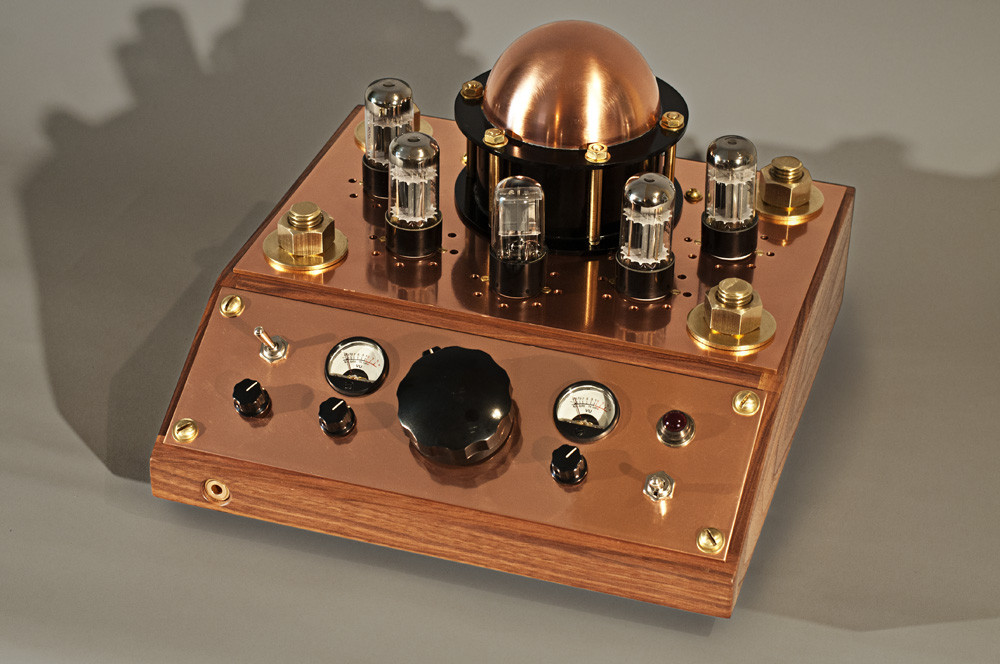
Technical characteristics of Deux Pre:
Construction: copper, brass, walnut.
Dimensions (inches): 12.5 wx 12.5 dx 8.25 h.
Weight: 20 pounds.
Input / output: 4 RCA Line-Level In, 1 stereo input 1/4, ribbon circuit, 1 output.
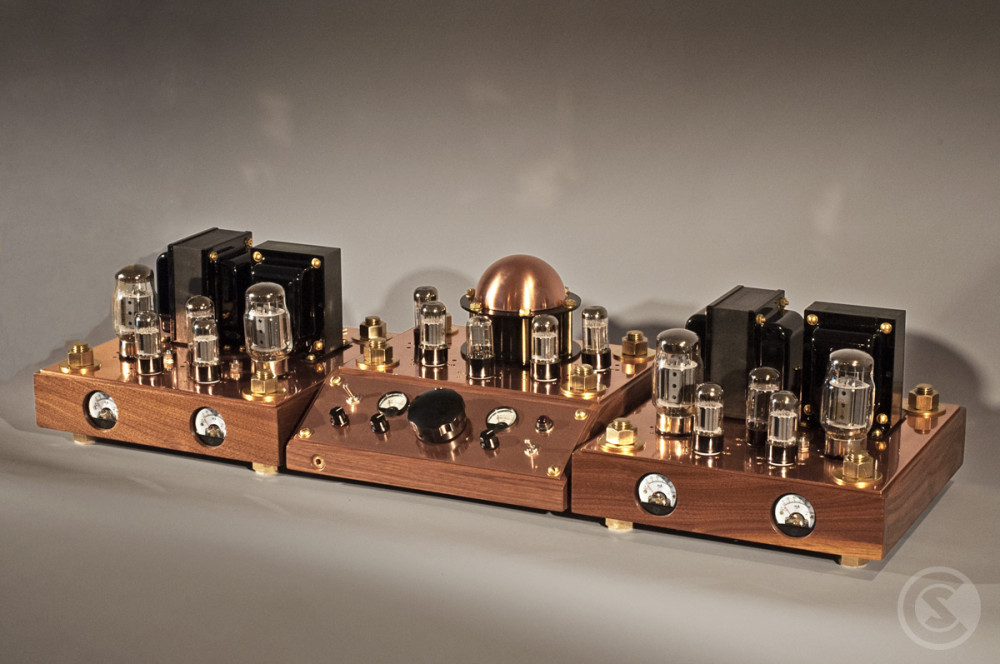
Specifications:
Construction: copper, brass, walnut.
Dimensions (inches): 12.5 wx 12, dx 8.25 h.
Weight: 30 pounds.
Output power: 60 W (continuous RMS at 8 ohms).
Output impedance: 4, 6 or 8 ohms.
Frequency range: from 20 Hz to 20 kHz.
Intermodulation distortion: less than 1% at 60 W; less than 0.5% of 50 watts below.
Input: RCA Line-Level.
The Æthereal One Tower Speaker speaker system also appeared a bit later. AU developed to complete the monobrand concept. It also did not go without an archaic approach - a broadband system, which is not very characteristic of modern acoustics.

Specifications of The Æthereal One Tower Speaker:
Somewhat later, the Steam Amp II appeared, which, like the first, was a set of an amplifier and a small broadband acoustic stereo system. One of the main differences of this device was the modified acoustic speaker design with spherical bodies. The amplifier still remained tube.

Specifications Steam Amp II:
I especially liked this device, as I am not indifferent to spherical acoustics due to its antiresonant qualities.
Some of these devices were also created in the city of St. Thomas, where Mike lived on the tiny island of Water Island. According to the designer, the environment and place of residence have a huge impact on creative productivity.
The work of one of the administrators of the Russian resource Tehnari.ru Valery Afanasyev is also recognized as a reference. Unlike Mike Cochran, Valery does not use tube circuitry (at least for those amps that I know). In order not to philosophize slyly and concentrate primarily on the stylistic design of the devices, Valery uses standard class D amplifiers. The display is based on the electromechanical principle.
Several amplifiers from Valery, which many consider to be true masterpieces, are considered to be canonical for Russian steampunk design in audio.
The first was the unnamed “Steampunk Audio Amplifier from Valery” with a mechanical spectrum indicator. The impressive design hinted at the steam principle of the device, since the details of the hull were made in the form of boilers connected by pipes.
A laser from a standard DVD was used as the light source for creating the indicator. In fact, this detail was a mechanical oscilloscope. (For details on how to create a link )

Later, a similar indicator appeared in an equally interesting device called “Audioscaphe”, made in the form of a steam boiler.
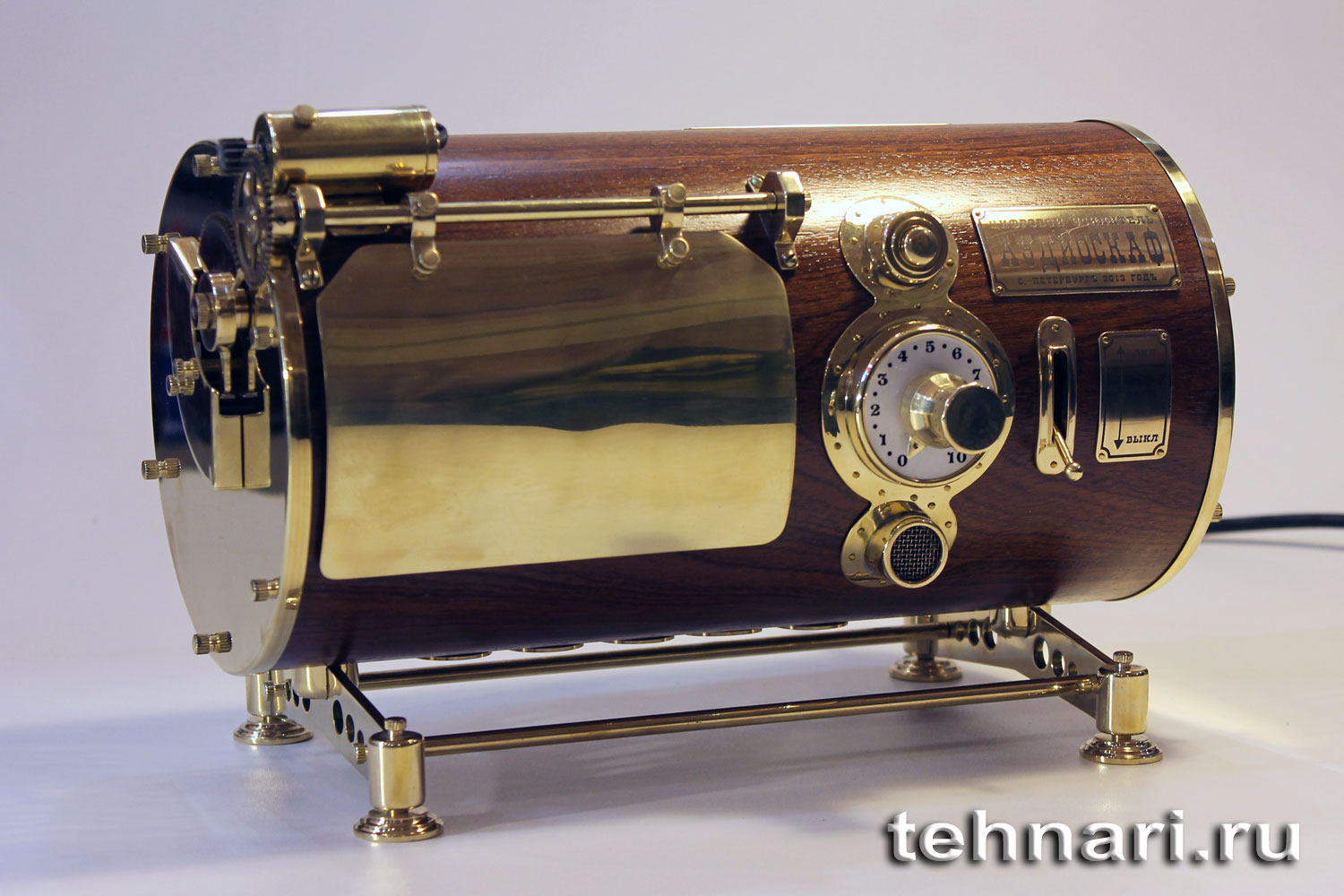
The video clearly shows the mechanical volume indicator, which rotates the arrow in accordance with the level. Technically, it is not difficult, while quite spectacular.
Another device Valery, deserve the attention of many fans of steampunk in Audio, was the “Samovarofon”.

The device also differed an outstanding indicator, however, as well as other aesthetic features. For example, the nameplate of the amplifier was made in the style characteristic of the Russian Empire of the late 19th and early 20th centuries.

The indicator of the samovarophone is green, the principle of operation is close to the first device.

Details on the device the author writes here: www.casemods.ru/section0/item1032
To consider the technical characteristics of the devices, I believe, is meaningless, since depending on the used components they can be practically any. I can only clarify that the power (RMS) of the samovarophone was about 100 watts.
Of the multifunctional devices with impressive decorative effects, it is worth noting the music center with the pathetic name “Parosound” or, in another way, “Music Box with a Steam Engine”.

It is probably difficult to come up with something visually more suitable for reproducing the compositions of the “Pre-Revolutionary Advisor” project. Literate lighting and other impressive visual effects of a few left indifferent to this device.
It should also be noted that several music centers were made. The main difference was the mechanism of the automation of the opening leaf of the CD player.
The story about the devices Afanasyev will not be complete, if not touch on the vinyl theme. So in 2014, the designer created a record player with the original vertical disc placement.

By analogy with other devices, the device received an interesting conceptual name “vertical gramophone“ Vertikrut ”
From the video we can conclude that the device has some problems with the stability of the rotation speed. This is probably due to the original location of the disc. I also do not know whether this problem has been solved. At the same time, the author clarified in the comments that there is no such problem, and the distortion is a recording problem.
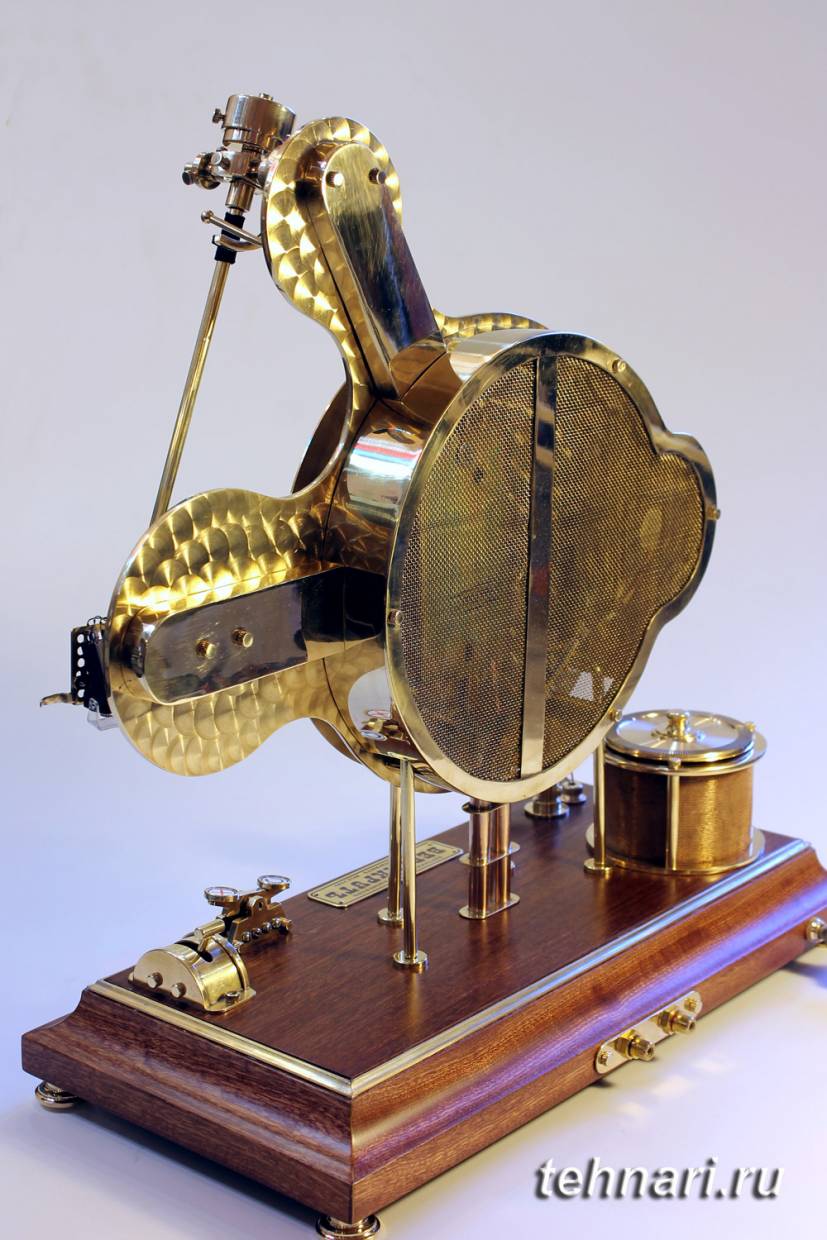
Anyway, visually the device is very impressive. Worked to the last button

It is known that the author sells his works, as well as that they are quite expensive.
To fit all the diversity of steampunk technology into one material is quite difficult. In case you have a desire to learn more about what is being created in this direction, I will be glad to write a few more posts. As in other materials of this kind, I suggest that users take part in a survey and express their attitude to such a phenomenon as steampunk in audio.
The post used photo coppersteam.com , tehnari.ru , as well as casemods.ru
A wide range of amplifiers , receivers and other sound-reproducing equipment is presented in our catalog . You can purchase both transistor and lamp UMZCH as well as high fidelity speaker systems from us .

The creators of pseudo-steam and deliberately analog audio works, as a rule, are singles who do for themselves or work on order for a particular client. Often impressive concepts appear not only among professionals, but also among amateurs.
Despite the relatively young fashion in the steampunk design of audio, enthusiasts managed to collect and (or) upgrade (customize) a lot of impressive, unusual devices. It is also interesting that in Russia there appear devices with a characteristic national flavor, some of them deserve special mention. Under the cat will be discussed several experiments in the design of audio devices that impressed me especially.
Copper steam
One of the pioneers of steampunk audio became Copper Steam. The appearance of this laboratory is directly related to the activities and aesthetic preferences of the designer and engineer Michael Cochran. The designer himself considers everything related to his concepts of “insane journey”, which began in 2008 on the wave of the growing popularity of steampunk as a literary and animated genre.
It all started in relatively poor artisanal conditions. The lab was a pair of tables in an old barn in the backyard of a designer house in Orlando. Mike began with the creation of accessories for the interior. The first works were sculptural compositions and pieces of furniture, made in the style characteristic of the steampunk universes.
Four years later, after moving from Orlando to Key West, Mike begins to create the first amplifiers. It should be noted that the designer chose the ideal time for the creation of steampunk amplifiers, since the vintage aesthetics he proposed became a genuine mainstream.
The latter circumstance largely determined the commercial success of the enterprise and made it possible to develop several areas and continue to create devices with a unique appearance. Probably, “warm” tube marketing also played its role. Almost all of the Copper Steam amplification for archaic and brutal trumpiness is based on the vacuum electric devices desired by audiophiles.
Experiments Copper Steam determined the canonical appearance of such devices (amplifiers and speakers). Many of those who began to engage in steampunk design and modding amplifiers relied on the techniques and principles laid down by Michael Cochran.
The first acoustic development of the Copper Steam was a small and low-cost Steam Amp. The model was a set of a complete tube amplifier and speaker system.

- Technical specifications Steam Amp:
- Construction: copper, brass, oak.
- Specifications:
- Dimensions (inches): 13w x 10d x 8h.
- Weight: 20 pounds.
- Output power: 8 W (continuous RMS at 8 ohms).
- Output impedance: 8 ohms.
- Input: 1/4 Line-Level.
- Speaker Parameters:
- Dimensions (inches): 7 wx 10 dx 9 h
- Weight: 8 pounds
- Power: 20 W at 8 Ohms
The following devices were designed for a more demanding audience, had more power, high fidelity to play and could impress experienced music lovers and audiophiles. The Deux lineup featured a DeuxPre stereo preamplifier and a DeuxAmp monoblock tip.

Technical characteristics of Deux Pre:
Construction: copper, brass, walnut.
Dimensions (inches): 12.5 wx 12.5 dx 8.25 h.
Weight: 20 pounds.
Input / output: 4 RCA Line-Level In, 1 stereo input 1/4, ribbon circuit, 1 output.

Specifications:
Construction: copper, brass, walnut.
Dimensions (inches): 12.5 wx 12, dx 8.25 h.
Weight: 30 pounds.
Output power: 60 W (continuous RMS at 8 ohms).
Output impedance: 4, 6 or 8 ohms.
Frequency range: from 20 Hz to 20 kHz.
Intermodulation distortion: less than 1% at 60 W; less than 0.5% of 50 watts below.
Input: RCA Line-Level.
The Æthereal One Tower Speaker speaker system also appeared a bit later. AU developed to complete the monobrand concept. It also did not go without an archaic approach - a broadband system, which is not very characteristic of modern acoustics.

Specifications of The Æthereal One Tower Speaker:
- Design: MDF, Walnut, maple, copper, brass.
- Dimensions (inches): 13 wx 13 dx 42 h.
- Weight: 60 pounds.
- Driver: 8 inches Tang Band w8-1808.
- Power: 30 W (continuous RMS), 60 W - peak (impedance: 8 ohms).
- Frequency response: 45 Hz to 20 kHz.
- Sensitivity: 93 dB.
Somewhat later, the Steam Amp II appeared, which, like the first, was a set of an amplifier and a small broadband acoustic stereo system. One of the main differences of this device was the modified acoustic speaker design with spherical bodies. The amplifier still remained tube.

Specifications Steam Amp II:
- Construction: copper, brass, walnut.
- Dimensions (inches): 13w x 13 dx 8 h.
- Weight: 40 pounds.
- Output power: 8 W (continuous RMS, 8 ohms).
- Output impedance: 8 ohms.
- Inputs: 4 RCA line inputs, 1/8 mini jack.
- Speaker Parameters:
- Dimensions (inches): 9 wx 9 dx 10 h.
- Weight: 10 pounds.
- Each driver: 4 inches Tang Band W4-1879.
- Power: 25 W at 8 Ohms.
I especially liked this device, as I am not indifferent to spherical acoustics due to its antiresonant qualities.
Some of these devices were also created in the city of St. Thomas, where Mike lived on the tiny island of Water Island. According to the designer, the environment and place of residence have a huge impact on creative productivity.
Russian steampunk from Valery Afanasyev
The work of one of the administrators of the Russian resource Tehnari.ru Valery Afanasyev is also recognized as a reference. Unlike Mike Cochran, Valery does not use tube circuitry (at least for those amps that I know). In order not to philosophize slyly and concentrate primarily on the stylistic design of the devices, Valery uses standard class D amplifiers. The display is based on the electromechanical principle.
Several amplifiers from Valery, which many consider to be true masterpieces, are considered to be canonical for Russian steampunk design in audio.
The first was the unnamed “Steampunk Audio Amplifier from Valery” with a mechanical spectrum indicator. The impressive design hinted at the steam principle of the device, since the details of the hull were made in the form of boilers connected by pipes.
A laser from a standard DVD was used as the light source for creating the indicator. In fact, this detail was a mechanical oscilloscope. (For details on how to create a link )

Later, a similar indicator appeared in an equally interesting device called “Audioscaphe”, made in the form of a steam boiler.

The video clearly shows the mechanical volume indicator, which rotates the arrow in accordance with the level. Technically, it is not difficult, while quite spectacular.
Another device Valery, deserve the attention of many fans of steampunk in Audio, was the “Samovarofon”.

The device also differed an outstanding indicator, however, as well as other aesthetic features. For example, the nameplate of the amplifier was made in the style characteristic of the Russian Empire of the late 19th and early 20th centuries.

The indicator of the samovarophone is green, the principle of operation is close to the first device.

Details on the device the author writes here: www.casemods.ru/section0/item1032
To consider the technical characteristics of the devices, I believe, is meaningless, since depending on the used components they can be practically any. I can only clarify that the power (RMS) of the samovarophone was about 100 watts.
Of the multifunctional devices with impressive decorative effects, it is worth noting the music center with the pathetic name “Parosound” or, in another way, “Music Box with a Steam Engine”.

It is probably difficult to come up with something visually more suitable for reproducing the compositions of the “Pre-Revolutionary Advisor” project. Literate lighting and other impressive visual effects of a few left indifferent to this device.
It should also be noted that several music centers were made. The main difference was the mechanism of the automation of the opening leaf of the CD player.
The story about the devices Afanasyev will not be complete, if not touch on the vinyl theme. So in 2014, the designer created a record player with the original vertical disc placement.

By analogy with other devices, the device received an interesting conceptual name “vertical gramophone“ Vertikrut ”
From the video we can conclude that the device has some problems with the stability of the rotation speed. This is probably due to the original location of the disc. I also do not know whether this problem has been solved. At the same time, the author clarified in the comments that there is no such problem, and the distortion is a recording problem.

Anyway, visually the device is very impressive. Worked to the last button

It is known that the author sells his works, as well as that they are quite expensive.
Total
To fit all the diversity of steampunk technology into one material is quite difficult. In case you have a desire to learn more about what is being created in this direction, I will be glad to write a few more posts. As in other materials of this kind, I suggest that users take part in a survey and express their attitude to such a phenomenon as steampunk in audio.
The post used photo coppersteam.com , tehnari.ru , as well as casemods.ru
A wide range of amplifiers , receivers and other sound-reproducing equipment is presented in our catalog . You can purchase both transistor and lamp UMZCH as well as high fidelity speaker systems from us .
All Articles